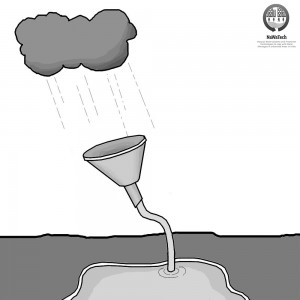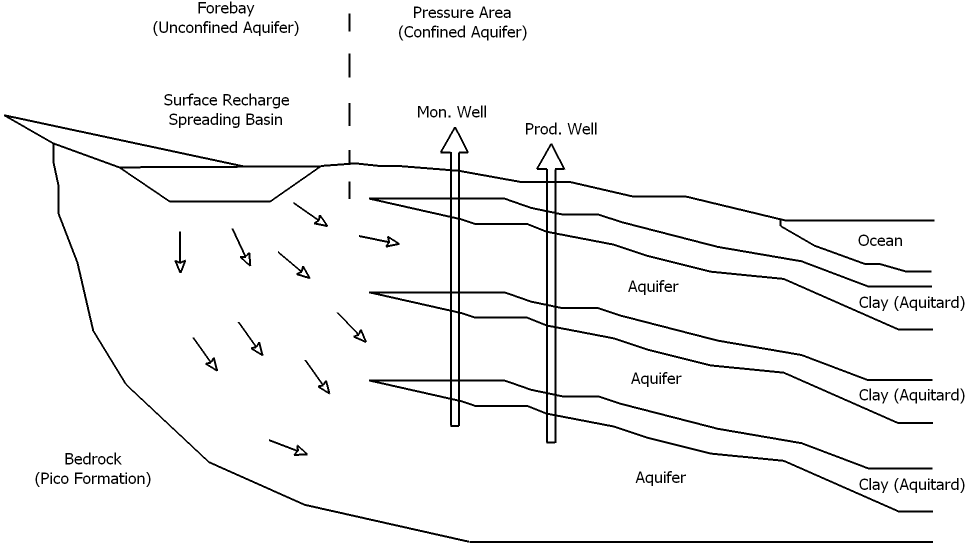Executive Summary
Groundwater recharge is an engineered process of replenishing the aquifer with water from the surface at an exceeding rate than the natural recharge rate. Over exploitation of groundwater has resulted in the depleting groundwater table in urban areas around the world. Groundwater recharge is the management of aquifer by reducing the water lost due to runoff and evaporation and redirecting to the excess water into the ground either by spreading on the surface or recharge basins or by altering natural conditions to increase infiltration to replenish an aquifer. All types of sources including fresh water, storm water and wastewater can be used for the groundwater recharge.
Design and Construction Principles
The factors for consideration for surface groundwater recharge are quality and quantity of water available, clogging potential, underground aquifer space available and transmission characteristics of aquifer. The groundwater recharge is governed by geological and hydrological characteristics of the aquifer system. The design approach includes the distribution of the head and a stress prior to and during project operations, hydraulic properties and the fate of artificially recharged water. Important aspect in design is to identify basin compartmentalisation or impermeable layers within the aquifer that inhibit recharge to the aquifers. Another design consideration is the mixing of surface water and native groundwater, hydrological variability with the aquifers and nature of recharged water. Before implementing chemical and physical modelling of recharge options, detailed analysis of co-mingled water that have different initial chemical signatures, and measurement of recharge rates is required. The surface groundwater recharge techniques include: surface spreading techniques, flooding, ditches and furrows, recharge basins, runoff conservation structures, gully plugs, stream-channel modification and surface irrigation. The selection of type of technique depends on the local conditions and the land usage pattern.
Operation and Maintenance
Periodic maintenance is required for effective recharge, because the infiltration capacity is affected adversely due to silting, precipitation and accumulation of organic matter (BROWN & KEYS 1985). There is limited monitoring and operations for the surface groundwater recharge.
Cost Considerations
The cost for construction and maintenance of the surface groundwater recharge scheme depends on the degree of treatment of the source water, the distance over which the source water needs to be transported and the stability of the recharge structure and resistance to silting and/or clogging. The capital cost for implementation of surface groundwater recharge scheme includes the land cost and the possible landscaping and modification of the area. In the urban areas this could be the limiting factor for implementation of surface groundwater recharge. The regular maintenance cost is minimal apart from some resources required for removal of deposited slit or organic matter, which is usually removed in 5-7 years.
Experiences in Europe and other Cities of the World
Surface groundwater recharge has been implemented around the globe. Surface groundwater recharge using treated wastewater has been implemented in the arid areas of Australia and in several states of the US including Arizona, California, Florida, New York and Texas (BEATTIE et al. 1978; BOUWER & RICE 1984; BROWN & KEYS 1985, KIMREY & FAYARD 1984; NELLOR 1984; OCWD 1991; SEABURN & ARONSON 1984). Some countries, for example, the Hashemite Kingdom of Jordan and the Kingdom of Saudi Arabia, have a national policy to reuse all treated wastewater effluents and have made considerable progress toward this end. The Dan Reclamation Project in Israel utilises secondary effluent for aquifer recharge using surface spreading via recharge basins (KANAREK & MICHAIL 1996). Surface recharge techniques such as infiltration basins and the ditch and furrow method achieve high rates of removal of organics, BOD, COD, nitrogen, phosphorus and coliforms (PESCOD 1992).
Experiences in India
Surface recharge through percolation tanks or spreading basins is the most common method in India to recharge groundwater both in alluvial and hard rock formations. The efficiency of these structures is more in hard rock formation where the rocks are highly fractured and weathered. In the States of Maharashtra, Andhra Pradesh, Madhya Pradesh, Karnataka and Gujarat, percolation tanks have been constructed in basaltic lava flows and crystalline rocks. However, surface recharge cannot occur in clayey soils, which have low permeability (CGWB 2009; NDWM 1989).
Vertical recharge shafts can be provided in case of land constraints. In India, these have been constructed in Kurukshetra District, Haryana to obtain silt free water, Sangrur District, Punjab to treat surface runoff with heavy silt and New Delhi to recharge groundwater with rooftop and surface runoff (CGWB 2009).
There is limited experience with groundwater recharge using treated wastewater in India. However, one pilot scale study was carried out in Ahmedabad to assess the potential of aquifer to treat primary treated wastewater. Primary treated domestic wastewater was used in order to address the cost and operative constraints of secondary wastewater treatment. It was suggested that the climate and characteristics of wastewater under Indian conditions, especially suspended solids, aid primary clarification and therefore increase the acceptability of primary effluent for recharge (NEMA et al. 2001).
Artificial Recharge of Groundwater in Queensland, Australia
Renovation of Wastewater at the 23rd Avenue Rapid Infiltration Project
After successful demonstration of the SAT principle with an experimental project in the Salt River bed west of Phoenix, the city of Phoenix was interested in renovating wastewater by soil-aquifer filtration on a larger scale. This led to the construction of the 23rd Avenue Project in 1975.
BOUWER, H. ; RICE, R.C. (1984): Renovation of Wastewater at the 23rd Avenue Rapid Infiltration Project. In: Journal Water Pollution Control Federation: Volume 56 , 76-83. URL [Accessed: 23.04.2015]Effects of Artificial Recharge on the Ogallala Aquifer, Texas
Four recharge tests were conducted by injecting water from playa lakes through wells into the Ogallala Formation. Injection was by gravity flow and by pumping under pressure. At one site, 34-acre feet of water was injected by gravity and produced a significant increase in yield of the well. At a second site, gravity injection of only 0.58 acre-foot caused a significant decrease in permeability due to plugging by suspended sediment. At two other sites, injection by pumping 6 and 14 acre- feet respectively, resulted in discharge of water at the surface and in perching of water above the water table. Differences in success of recharge were largely due to aquifer lithology and, therefore, the type of permeability; the concentration of suspended solids in the re- charge water; and the injection technique.
BROWN, R.F. KEYS, W.S. (1985): Effects of Artificial Recharge on the Ogallala Aquifer, Texas. (= United States Geological Survey Water Supply Paper , 225 ). Alexandria: U.S. Geological Survey URL [Accessed: 23.04.2015]Groundwater Recharge with Municipal Effluent: Dan Region Reclamation Project, Israel
The Dan Region Project is the largest water reclamation scheme in Israel which provides for collection, treatment, groundwater recharge and reuse of municipal wastewater from Tel-Aviv metropolitan area and several other neighboring municipalities. The project serves a total population of about 1.3 million with an average municipal wastewater flow of 270,000 cu.m/d.
KANAREK, A. ; MICHAIL, M. (1996): Groundwater Recharge with Municipal Effluent: Dan Region Reclamation Project, Israel. In: Water Science and Technology: Volume 34 , 227-233. URL [Accessed: 23.04.2015]Geohydrologic Reconnaissance of Drainage Wells in Florida
Guide on Artificial Recharge to Groundwater
This document provides guidance on artificial recharge techniques and designs and the planning and monitoring of artificial recharge projects.
MINISTRY OF WATER RESOURCES (2000): Guide on Artificial Recharge to Groundwater. New Delhi: Central Ground Water Board URL [Accessed: 21.03.2019]Health Effects Study
Techno-Economic Evaluation of Soil-Aquifer Treatment Using Primary Effluent at Ahmedabad, India
A pilot study was carried out in Sabarmati River bed at Ahmedabad, India for renovation of primary treated municipal wastewater through soil aquifer treatment (SAT) system. The infrastructure for the pilot SAT system comprised of two primary settling basins, two infiltration basins and two production wells located in the centre of infiltration basins for pumping out renovated wastewater.
NEMA, P. ; OJHA, C.S. ; KUMAR, A. ; KHANNA, P. (2001): Techno-Economic Evaluation of Soil-Aquifer Treatment Using Primary Effluent at Ahmedabad, India. In: Water Research: Volume 35 , 2179-2190. URL [Accessed: 11.05.2015]Groundwater Management Plan: Orange County Water District
Wastewater Treatment and Use in Agriculture
This Irrigation and Drainage Paper is intended to provide guidance to national planners and decision-makers, agricultural and municipal managers, field engineers and scientists, health and agricultural field workers, wastewater treatment plant operators and farmers. Consequently, it covers a broad range of relevant material, some in considerable depth but some more superficially. It is meant to encourage the collection, treatment and use of wastewater in agriculture in a safe manner, with maximum advantage taken of this resource. Informal, unplanned and unorganized wastewater use is not recommended, nor is it considered adviseable from the health or agricultural points of view.
PESCOD, M.B. (1992): Wastewater Treatment and Use in Agriculture. (= FAO Irrigation and Drainage Paper , 47 ). Rome: Food and Agriculture Organisation of the United Nations (FAO) URL [Accessed: 25.10.2011]Influence of Recharge Basins on the Hydrology of Nassau and Suffolk Counties, Long Island, New York
An investigation of recharge basins on Long Island was made by the U S Geological Survey in cooperation with the New York State Department of Environmental Conservation, Nassau County Department of Public Works, Suffolk County Department of Environmental Control, and Suffolk County Water Authority. The major objectives of the study were (I) catalog basic physical data on the recharge basins, in use on Long Island, (2) measure quality and quantity of precipitation and inflow, (3) measure infiltration rates at selected recharge basins, and(4) evaluate regional effects of recharge basins on the hydrologic system of Long Island. The area of study consists of Nassau and Suffolk Counties - about 1,370 square miles - in eastern Long Island, NY.
SEABURN, G.E. ARONSON, D.A. (1974): Influence of Recharge Basins on the Hydrology of Nassau and Suffolk Counties, Long Island, New York. (= Geological Survey Water-Supply Paper , 2031 ). Washington: United States Government Printing Office URL [Accessed: 11.05.2015]Compendium of Natural Water Systems and Treatment Technologies to cope with Water Shortages in Urbanised Areas in India
The Compendium of NaWaTech Technologies presents appropriate water and wastewater technologies that could enable the sustainable water management in Indian cities. It is intended as a reference for water professionals in charge of planning, designing and implementing sustainable water systems in the Indian urban scenario, based on a decentralised approach.
BARRETO DILLON, L. ; DOYLE, L. ; LANGERGRABER, G. ; SATISH, S. ; POPHALI, G. (2013): Compendium of Natural Water Systems and Treatment Technologies to cope with Water Shortages in Urbanised Areas in India. Berlin: EPUBLI GMBH URL [Accessed: 11.12.2015]http://www.nawatech.net/
This is the official webpage of the NaWaTech Collaborative Project, containing all key information related to the different case studies, activities and results of the project.




